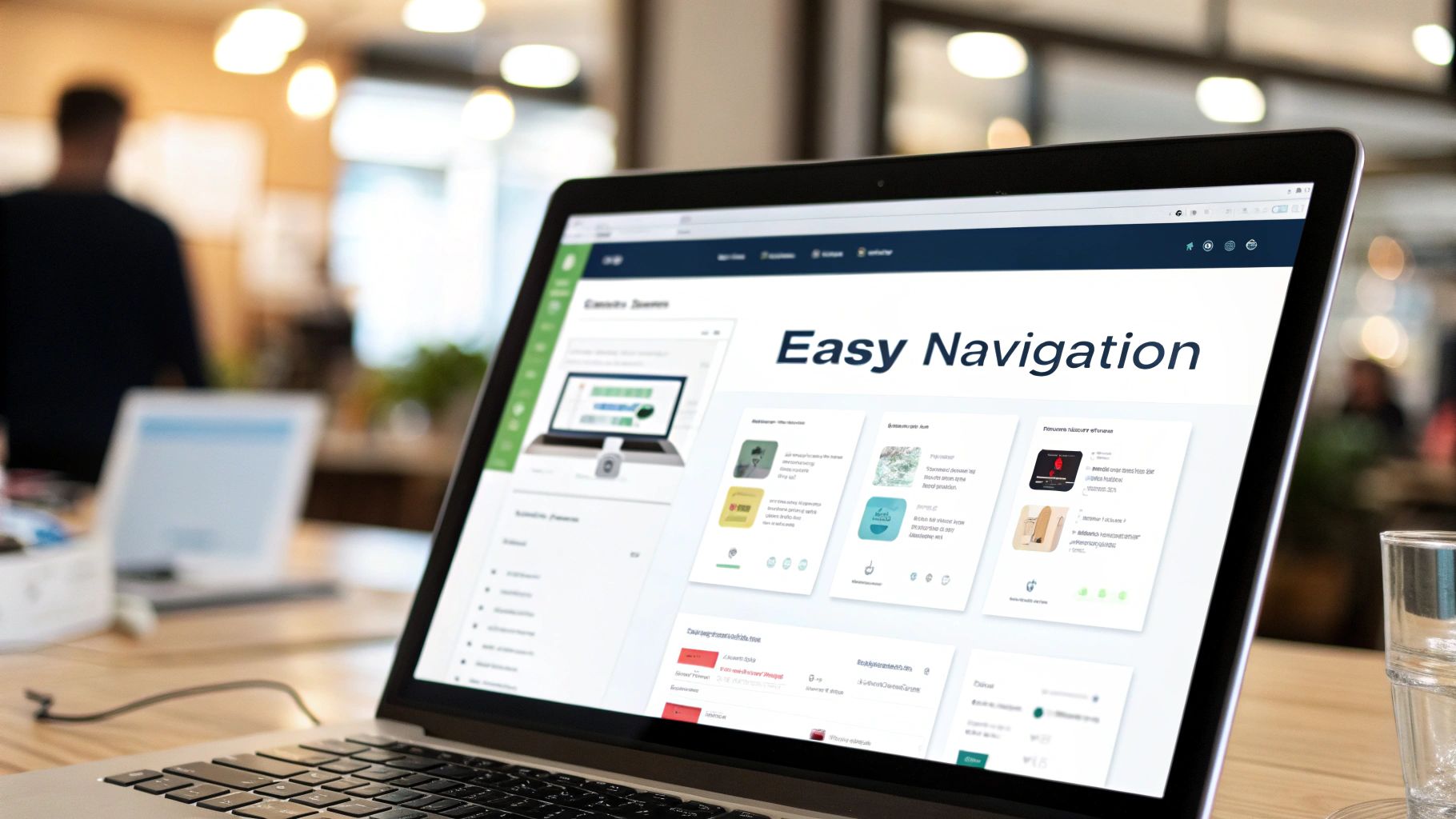Understanding The Strategic Impact of Theme Customization

When it comes to Shopify themes, customization is much more than aesthetics. A well-customized theme can boost sales, improve user experience, and help build a stronger brand. Learning how to customize your theme is key for business growth.
Evaluating Your Current Theme's Limitations
Start by taking a close look at your current theme setup. Ask yourself: Does it match your brand's unique style? Can customers easily find what they need? Many themes look good at first glance but lack important features like product filters or user-friendly blog layouts. Spotting these gaps helps you plan smart improvements.
Identifying Opportunities For Impactful Customization
After finding weak spots in your theme, focus on changes that will make the biggest difference. You might need better product pages that highlight key features, or a simpler checkout to reduce abandoned carts. Other important areas include mobile design, page load speed, and making your site accessible to all users. Put your effort where it counts most.
Developing a Strategic Approach
Good theme customization needs a clear plan tied to your business goals. For example, if you want to increase average orders, modify product pages to show related items. If building community matters most, add reviews and social media feeds. The numbers show how important custom themes are - 2,328,071 websites use custom Shopify themes, with 850,464 active sites today and 1,477,607 historical users according to BuiltWith's latest data. Having a focused strategy helps you get the most from your customization work.
Building Your Theme Customization Toolkit
Setting up proper tools and workflows makes a huge difference for Shopify theme customization projects. Like any skilled craft, success comes from having the right toolkit to work effectively.
Essential Tools for Shopify Theme Customization
Here are the key tools needed for theme customization:
-
Code Editor: A quality editor like VS Code, Atom, or Sublime Text helps you write code faster with features like syntax highlighting and autocompletion. This makes editing theme files much simpler.
-
Version Control: Git helps track changes and collaborate with others. Platforms like GitHub let you store and manage code safely. This keeps development organized.
-
Local Environment: Testing changes locally protects your live store from mistakes. This sandboxed approach lets you fully test updates before going live.
-
Theme Kit: Shopify's Theme Kit connects directly to your theme files for easy uploading, downloading and previewing. It works smoothly with local development.
Making the Most of Shopify's Tools
Shopify includes powerful built-in features for customization:
-
Theme Editor: Make basic changes to colors, fonts, and layouts through the visual editor. Great for simple tweaks.
-
Liquid Language: Liquid lets you add dynamic content and custom logic to themes. Master this to unlock endless customization options.
Custom Shopify themes give brands unique control over their store experience. Unlike pre-built themes with limited options, custom themes can fully match your brand's look and needs. This uses Shopify's APIs and Liquid to build custom features. Learn more about custom vs pre-built themes.
Creating Strong Workflows
A clear workflow boosts productivity. Try these best practices:
-
Work in Modules: Break complex changes into smaller pieces. This makes code easier to manage and fix.
-
Back Up Often: Save theme files regularly to prevent data loss. Quick restores keep you moving if issues occur.
-
Test Everything: Check all parts of your customization - features, mobile display, and speed.
With the right tools and solid workflows, you'll be ready to tackle any theme customization project. This foundation helps create unique, high-performing stores that fit your brand perfectly.
Mastering Essential Customization Techniques

Successful Shopify theme customization requires more than just having the right tools - it's about knowing how to use them effectively. Let's explore practical techniques for modifying layouts, adding features, and making your store look great across all devices.
Modifying Layouts for Enhanced User Experience
One key aspect of customization is layout control. You can adjust content widths, reposition page elements, and design new sections to match your vision. For instance, you might place product descriptions on the left and images on the right to create a more engaging product page. These layout changes help improve conversions and make shopping easier.
Implementing Dynamic Features With Liquid
Dynamic features can take your store to the next level. Using Shopify's Liquid template language, you can create personalized content and interactive elements that respond to user actions. Consider adding targeted product recommendations or welcome messages for returning customers. These personal touches create a much better shopping experience than static pages.
Creating Responsive Designs for All Devices
Mobile optimization is essential for modern online stores. Your Shopify theme needs to work perfectly on every screen size - from large desktop monitors to small phone screens. Make sure your images scale properly, text stays readable, and navigation remains easy to use no matter how customers browse your store.
Making the Most of Built-In Features
While custom code gives you lots of flexibility, Shopify's theme editor has many useful built-in options. You can change colors, fonts, and basic layouts without writing code. Many Shopify apps also integrate smoothly with themes to add new features without complex technical work.
Balancing Customization Costs and Benefits
The cost of customizing your Shopify theme varies based on what you want to achieve. Free themes offer basic options, while paid themes and custom development require more investment. For example, hiring a developer for specific changes adds to the cost but gives you exact control over your store's look and feel. Learn more about theme customization at DhiWise. Consider your budget and goals carefully to make smart investments in improvements that will benefit your business most.
Implementing Advanced Customization Solutions
Advanced Shopify theme customization gives you the tools to create unique and effective online stores. By mastering custom sections, dynamic features, and third-party integrations, you can build a store that stands out and delivers results. Let's explore these key techniques.
Creating Custom Sections
Custom sections let you take full control over specific areas of your Shopify theme. You might want to create a unique homepage section to showcase featured products or design a custom blog layout. This requires working directly with the theme's code using Liquid, but gives you the freedom to shape both design and content exactly how you want.
Integrating Dynamic Features
Dynamic features help create personalized shopping experiences that keep customers coming back. With Liquid, you can add smart features like:
- Product recommendations based on browsing history
- Custom greetings for returning customers
- Real-time inventory updates
- Time and location-based promotional messages
Seamless Third-Party Integrations
Adding third-party apps expands what your store can do. Whether connecting a loyalty program, reviews platform, or email marketing service, a customized theme makes integration smoother. Custom code helps these apps work seamlessly with your theme's design. The result is a more complete store that serves both customers and business goals. Learn more about the value of custom themes at SmartBug Media.
Troubleshooting and Maintenance
Advanced customizations need careful attention to run smoothly. Key maintenance tasks include:
- Testing thoroughly across devices and browsers
- Making regular backups to prevent data loss
- Keeping detailed documentation
- Using version control for easy updates
When you master these advanced techniques, you can create a truly unique Shopify store. While it takes deeper knowledge of Liquid and theme development, the results are worth it - you'll have a high-performing store that stands out from the competition.
Quality Assurance and Performance Optimization

After customizing your Shopify theme, thorough testing is essential to create a smooth customer experience and well-performing online store. While many skip this step, proper quality assurance makes all the difference in your store's success.
Testing Across Devices and Browsers
A complete testing process checks your theme on different devices and scenarios. Test on multiple screen sizes (desktop, tablet, mobile) and browsers (Chrome, Firefox, Safari, Edge) to ensure everything displays correctly. Try common customer actions like adding products to cart and checking out to catch any issues early.
Smart Debugging Approaches
Quick issue resolution requires effective debugging methods. Use browser developer tools to check code and test changes in real-time. The Shopify Theme Kit helps you manage theme files and speeds up testing. Good version control also helps track and fix problem areas.
Built-in Shopify Tools
Shopify provides several helpful testing features. Preview changes live in the Theme Editor and debug Liquid code right in the editor. Using these tools as part of your workflow helps spot and fix issues faster.
Adding Automated Tests
For bigger customization projects, automated testing can help. Tools like Theme Check find potential errors and performance problems automatically. This proactive approach helps prevent future issues.
Keeping Performance Strong
Regular performance checks are key, especially after making theme changes. Test core features, page speed, and mobile responsiveness often. This ongoing maintenance ensures your customized theme keeps working well for customers. With careful testing and monitoring, your Shopify theme will be both customized and reliable.
Long-Term Theme Management and Evolution
A custom Shopify theme is a key business asset that needs proper maintenance and strategic development over time. Success requires careful organization, smart planning, and reliable backup systems to protect your investment. Let's look at the key aspects of keeping your theme healthy.
Documenting Your Customizations
Good documentation acts as a guide for future work on your theme. Write down which files you modified, what specific changes you made, and why you made them. This creates a clear history that helps tremendously when you need to revisit changes later or bring new team members up to speed.
Managing Theme Updates Without Losing Customizations
Shopify releases regular theme updates with new capabilities and security fixes. To avoid losing your customizations when applying these updates, use a version control system like Git. This lets you track changes, safely merge updates, and restore previous versions if needed - keeping your theme current while protecting your custom work.
Implementing Robust Backup Strategies
Think of backups as insurance for your theme. Regular backups protect against errors, accidental deletions, and security issues. Use Shopify's built-in backup feature or add a backup service to automate the process. For extra safety, store copies in cloud storage separately from your shop.
Training Your Team
When multiple people work on your theme, everyone needs consistent training. Create clear guidelines for customizations, documentation, and version control. Review and update these guidelines regularly as Shopify adds new features. This helps prevent mistakes and keeps everyone following the same best practices.
Planning for Scale
Build your theme to grow with your business. Consider how adding new product lines or apps might affect your theme's structure. Planning ahead reduces the need for major changes later. Think about future needs when designing key theme elements.
Evaluating Theme Performance and Refreshing Your Design
Check your theme's performance against business goals regularly. Look at conversion rates and user experience metrics. If results aren't meeting targets, plan strategic updates. This could mean refreshing the design, making the site faster, or adding features your customers want. Your theme should keep pace with your evolving business needs.
Want to add new sections to your Shopify theme without complex coding? Check out ready-made sections. Add features easily through the theme editor without ongoing subscription costs. Learn more at Section Store.


